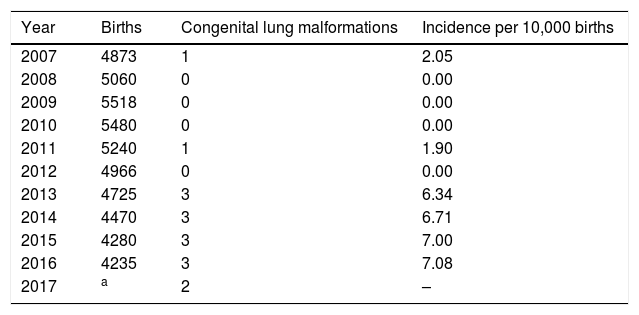Congenital lung malformations (CLMs) constitute a heterogeneous group of lung anomalies involving the airways, parenchyma and blood vessels. Historically, they have been considered infrequent, as their annual incidence has been documented to be of 1 case per 10,000–35,000 pregnancies1 or about 30–42 cases per 100,000 inhabitants in the general population. There are also authors that assert that their diagnosis has improved considerably with the introduction of routine prenatal ultrasound examinations,2 but few studies have analysed how their incidence has actually been changing in recent times.
In order to establish the incidence of CLMs in the autonomous community of Cantabria (Spain), we conducted a retrospective descriptive study of all cases of CLM managed in the Department of Paediatrics of the Hospital Universitario Marqués de Valdecilla in Santander, (Cantabria, Spain), specifically in the Units of Paediatric Pulmonology and Paediatric Surgery, in the period between January 2007 and December 2017. Our hospital is the tertiary care hospital that manages all complicated pregnancies in Cantabria, and we identified the patients using information obtained from the Department of Admissions and Clinical Records. In addition, we obtained data on the number of births during this period from the Instituto Cántabro de Estadística (Statistical Institute of Cantabria) and the Instituto Nacional de Estadística (National Institute of Statistics).
A total of 16 cases of CLM were diagnosed during the period under study, corresponding to 9 female patients and 7 male patients. The diagnosis was prenatal in 15 cases (93.7%), with the defect identified in the ultrasound examination performed at 22 weeks’ gestation. All of these patients were evaluated with a chest radiograph and a chest ultrasound examination within 24h from birth, and these imaging tests confirmed the presence of a CLM in the patients whose second trimester ultrasound examination had been positive. In the remaining patient, treated in 2007, the CLM was diagnosed at age 4 months by means of a chest radiograph and a computed tomography angiogram.
Table 1 presents the data on the annual incidence of CLM. The mean annual incidence was of 2.05 cases per 10,000 births (standard deviation, 3.26) and the median was 1.98 cases (interquartile range, 6.79), calculated with data through December 2016. We could not calculate the incidence for 2017 because at the time of this writing there is no published data on the number of births in Cantabria during this year. We ought to highlight the considerable variability between years, as 2 cases were diagnosed in a total of 31,137 children born between 2007 and 2012, compared to 12 cases diagnosed in a total of 17,710 children born between 2013 and 2016.
Annual incidence of congenital lung malformations in Cantabria, 2007–2016.
| Year | Births | Congenital lung malformations | Incidence per 10,000 births |
|---|---|---|---|
| 2007 | 4873 | 1 | 2.05 |
| 2008 | 5060 | 0 | 0.00 |
| 2009 | 5518 | 0 | 0.00 |
| 2010 | 5480 | 0 | 0.00 |
| 2011 | 5240 | 1 | 1.90 |
| 2012 | 4966 | 0 | 0.00 |
| 2013 | 4725 | 3 | 6.34 |
| 2014 | 4470 | 3 | 6.71 |
| 2015 | 4280 | 3 | 7.00 |
| 2016 | 4235 | 3 | 7.08 |
| 2017 | a | 2 | – |
These data are consistent with the findings of a study by Stocker et al.,3 who also found a significant interannual variability and reported an incidence of 1.27 cases per 10,000 births between 1994 and 1998 and an incidence that was nearly triple of 4.15 cases per 10,000 births between 2008 and 2012. Given the increase in the number of CLMs in recent years, we need to consider whether this results from an actual increase in incidence or improvements in diagnostic techniques. Stocker et al.3 favour the hypothesis of an increased incidence, which is also supported by data in the EUROCAT registry, which shows an increase of 6.5% in some CLMs (95% CI, 3.5%–9.4%), a phenomenon for which there is currently no plausible explanation.4
A salient finding in our study was the predominance of the female sex, contrary to previous studies,5 which have historically reported a predominance of the male sex. This fact, along with the significant interannual variability, suggests that further studies with a longer follow-up are required to establish the current actual incidence of CLMs, which will also require the participation of a larger number of hospitals to increase the number of cases included in the analyses. Establishing the incidence of CLMs more accurately is relevant for the purpose of improving the management of these patients, as the increase in the number of cases diagnosed prenatally has raised controversy regarding the correct approach to the management of asymptomatic patients.6
Please cite this article as: Sancho Gutiérrez R, Pérez Belmonte E, de Diego García E, López López AJ, Cabero Pérez MJ. ¿Varía la incidencia de las malformaciones pulmonares congénitas?: 11 años de experiencia. An Pediatr (Barc). 2019;91:53–54.




